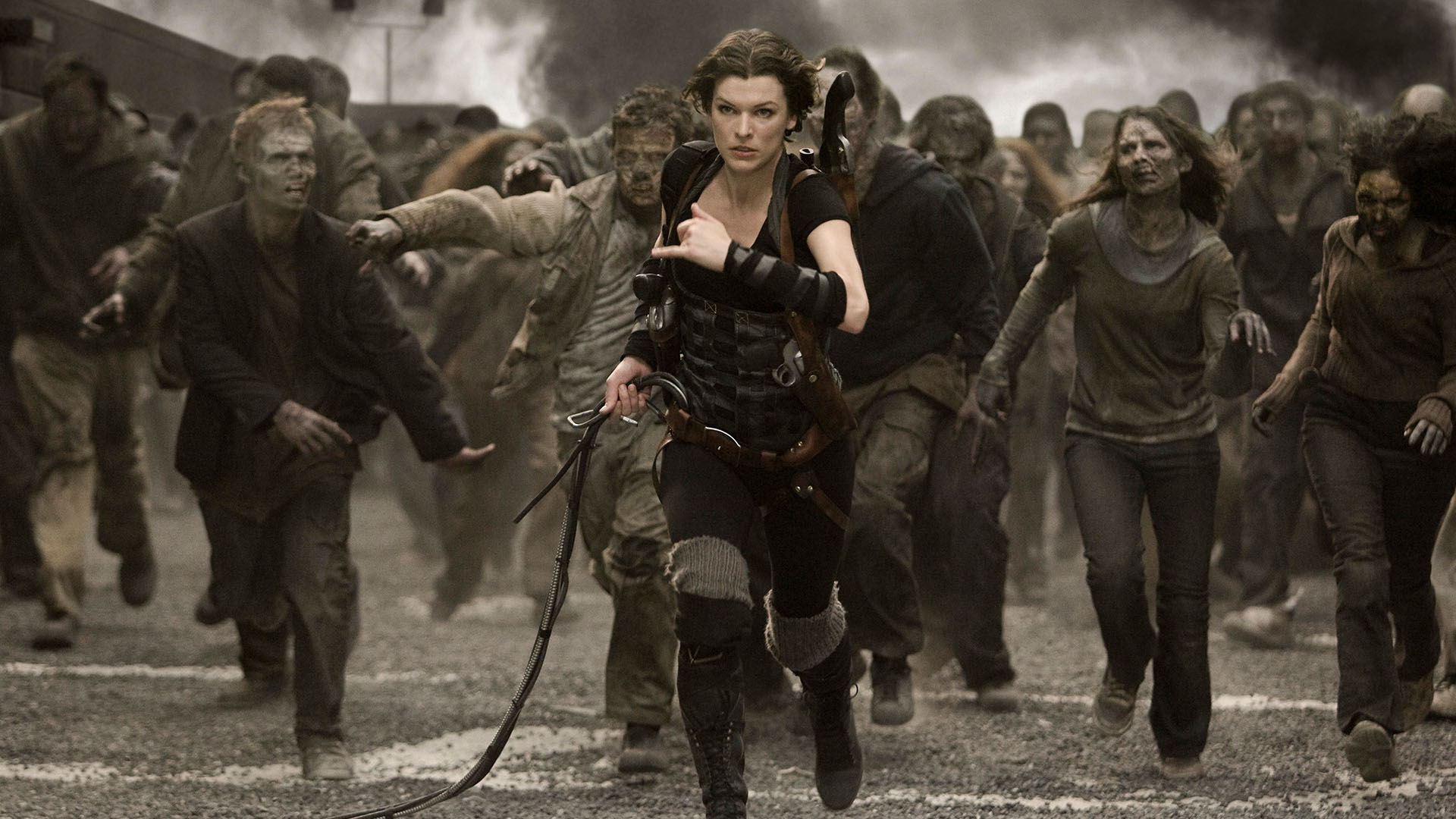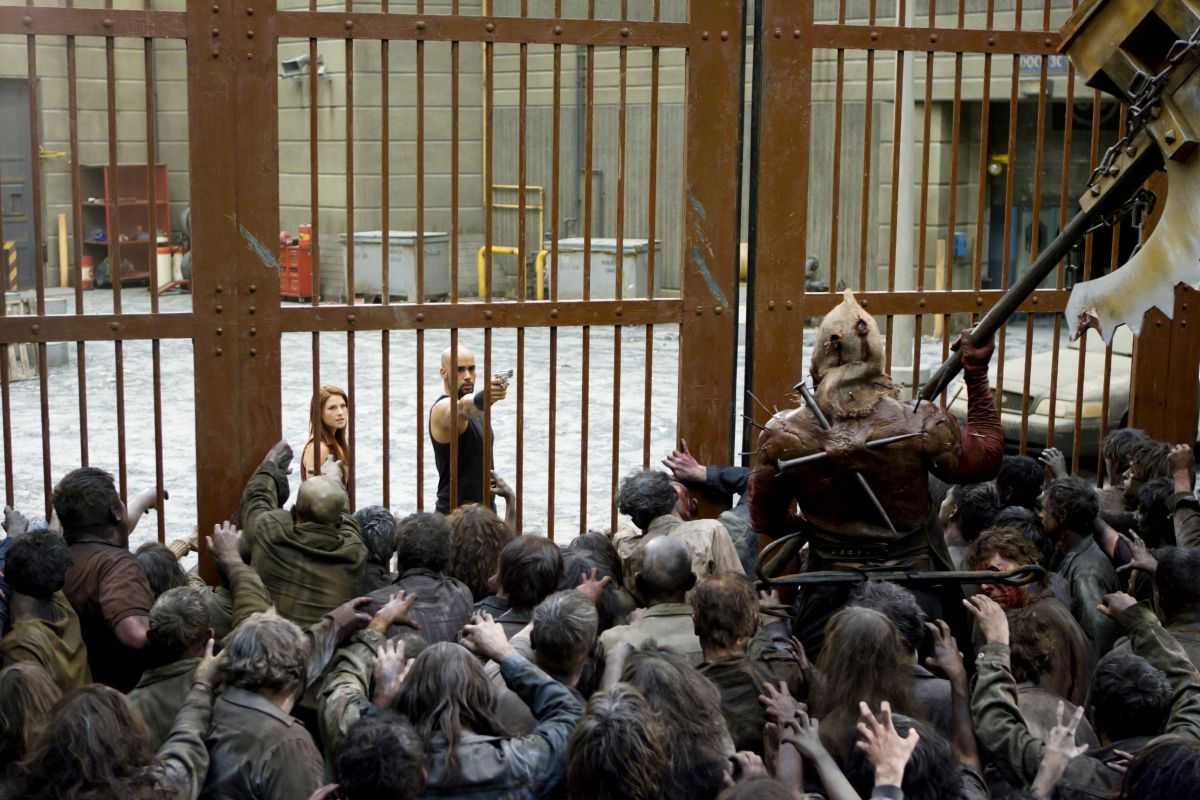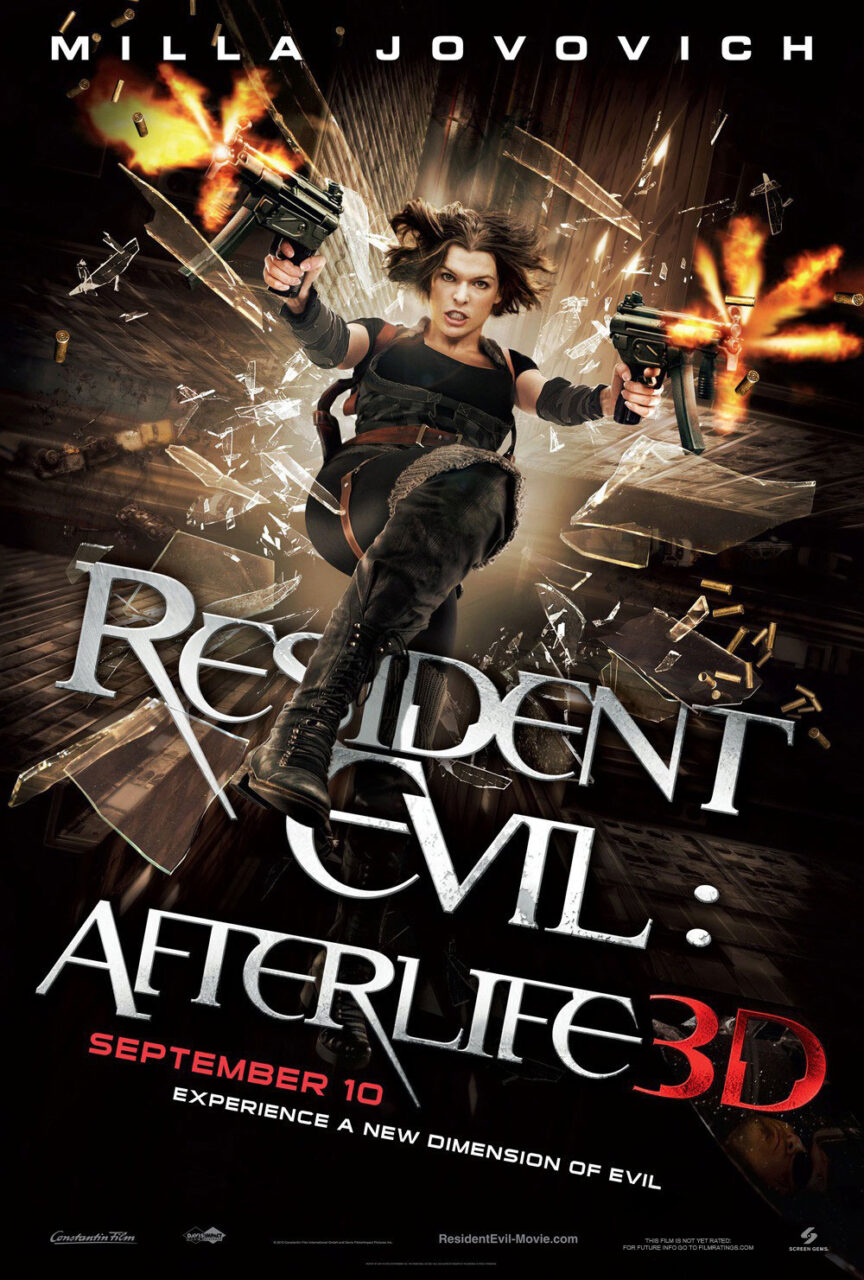USA/Germany/UK. 2010.
Crew
Director/Screenplay – Paul W.S. Anderson, Based on the Videogame Created by Capcom, Producers – Paul W.S. Anderson, Jeremy Bolt, Don Carmody, Bernd Eichinger, Samuel Hadida & Robert Kulzer, Photography (3-D) – Glen MacPherson, Music – tomandandy, Visual Effects Supervisor – Dennis Berardi, Creature Effects – Paul Jones FX Studio, Production Design – Arv Grewal. Production Company – Constantin Film/Davis Film/Impact Pictures.
Cast
Milla Jovovich (Alice), Ali Larter (Claire Redfield), Wentworth Miller (Chris Redfield), Boris Kodjoe (Luther West), Shawn Roberts (Albert Wesker), Kim Coates (Bennett), Spencer Locke (K-Mart), Kacey Barnfield (Crystal), Sergio Peris-Mencheta (Angel Ortiz), Norman Yeung (Kim Yong), Fulvio Cecere (Wendell)
Plot
The clones of Alice are destroyed while mounting an assault the Umbrella Corporation’s underground complex. As Alice tries to stop Albert Wesker escaping, he injects her with a formula that neutralises her psychic powers. Alice flies up to Alaska in a small plane to join her friends who went in search of the sanctuary of Arcadia. She lands to find nothing at the given coordinates and is puzzled what has happened to everybody. She is then attacked by a crazed Claire Redfield and disarms a mind control device attached to her chest. Alice flies back to Los Angeles, taking a slowly recovering amnesiac Claire with her. There they find a group of survivors who have taken refuge in a prison building that is surrounded by zombies. Alice makes a precarious landing on the roof. The survivors reveal that Arcadia is in fact a giant oil tanker that has now moored just off the coast. Alice tries to devise a means of getting the group out to safety past the zombies and to the coast to rendezvous with Arcadia.
Afterlife is the fourth of the Resident Evil films. The series began with Resident Evil (2002) from director Paul W.S. Anderson and starring Milla Jovovich. This was followed by two sequels Resident Evil: Apocalypse (2004) and Resident Evil: Extinction (2007), both starring Milla Jovovich, and the subsequent Resident Evil: Retribution (2012) and Resident Evil: The Final Chapter (2016), while there was also the prequel Resident Evil: Welcome to Raccoon City (2021). (There were also three anime films with Resident Evil: Degeneration (2008), Resident Evil: Damnation (2012) and Resident Evil: Vendetta (2017), as well as the anime tv series Resident Evil: Infinite Darkness (2021) and the live-action tv series Resident Evil (2022), which stand alone from these live-action films and do not feature the character of Alice). These in turn were based on the Resident Evil computer games, which first appeared in 1996 and have spawned over twenty spin-off games to date. For the other sequels, Paul W.S. Anderson took a backseat position writing the script and producing, but made a return to the director’s chair here.
Resident Evil: Afterlife comes in the fad de jour of 3-D, which has become a bandwagon that every second film coming out in 2010 has attempted to jump aboard following the massive success of Avatar (2009). The upshot of this has been to reduce the possibilities of the process to no more than a tired gimmick – in an effort to hitch Resident Evil: Afterlife to the Avatar bandwagon, for example, Paul W.S. Anderson even went so far as to advertise that he had shot in the Fusion Camera process that James Cameron had used, as though that provided a distinction that stood his film above the other copycats.
I greeted Resident Evil: Afterlife with zero interest, turned off by a combination of over-inflated 3-D ticket prices and another unnecessary entry in a mediocre series that not even the fans of the videogames seemed enthused about. And up on screen, Afterlife demonstrates that it is well and truly time that someone retired the Resident Evil film series. The series peaked with Resident Evil: Apocalypse and has managed to stagger through five films by dragging the basics of the George Romero zombie films through little more than a flurry of overblown action moves, a good deal of tiresome posing, a supposedly R-rated gore level that barely pushes the line of a PG-13 rating, and the non-acting Milla Jovovich perpetually trying to carve out an action career for a fan audience that must barely number itself in the double digits.

Even amid the reduced expectations of the Resident Evil series, Afterlife hits an absolute low point. It is hard to see why Paul W.S. Anderson saw the need to return to the series and spend a couple of years making a film that seems to have been flown in on autopilot by everybody involved as the time would surely have been better spent developing one of the other numerous projects he has been associated with over the last few years. Resident Evil: Afterlife has the feeling of a film where everybody knew they had a built-in audience and made the most minimal effort to fulfil the requirements of a Resident Evil film. This might suffice if one is making say a Friday the 13th sequel, but for a film where one is being expected to pay way over and above the usual ticket price because it is being sold in 3-D, this amounts to no more than apathetic exploitation.
Not much in the film makes sense. The film opens on a prologue where Milla Jovovich and an army of clones attack an Umbrella Corporation underground complex, resulting in an explosion that obliterates all of the clones. The real Milla then gets aboard the plane as Wesker (Shawn Roberts) makes an escape where he injects her with a fluid that removes all of her psychic powers, before both appear to be killed as the plane explodes into a hillside. This is incredibly lazy writing – where rather than follow on from the events introduced in the previous films and develop the scenario and characters, Anderson lazily eliminates the clones and Alice’s psychic powers, in effect hitting the reset button back to the status quo of the series. It feels like another equivalent of the amnesia-inducing kiss in Superman II (1980) or a 1960s/70s tv series where any romance or life change that altered the status quo would be written out by the next episode.
The worst parts of Afterlife is the middle two-thirds when the film arrives at the prison. This entire section seems filled with characters and scenarios that are tossed in and then thrown away by the next scene. We are introduced to a cross-section of survivors – an asshole Hollywood producer and his downtrodden p.a., a sports star who had brand-named a clothing empire, a would-be actress (English actress Kacey Barnfield trying to pull off a Kiwi accent for some reason) who has been reduced to waiting tables and a couple of others that are give no more depth than names – only in most cases to kill them off the next time we see them. There are a number of dramatic possibilities introduced – a giant-size APC that would allow them to burst out past the mass of zombies, an armoury that requires access via flooded sections of the jail – but after being built-up, both of these are tossed aside before anything is done with them. There is a giant known as The Axeman who batters down the gates with what looks like a massive-sized lethally armoured meat tenderiser and engages in a bathroom-destroying battle with Milla Jovovich but there is no explanation of what it is meant to be or where it comes from. Equally, the credits open over a sequence set in what looks like a Japanese street where a woman turns into a zombie and attacks a businessman, which relates to nothing else that happens in the film and is especially confusing given that it takes place in a busy inhabited city and the rest of the film demonstrates that there are only a handful of survivors left around the world. [Although this does get an explanation in the subsequent film].
T

he worst of these seeming random plotting cul-de-sacs is the character of Wentworth Miller. We are first introduced to him imprisoned in a cage where he then tries to convince Milla Jovovich that former inmates locked him away out of a sense of ironic justice because he was a law enforcement officer. In this scene, what he says he is played with an ambiguity as though we are not meant to be sure whether we can trust what he says. The subsequent sections of the film require the group to trust him after which Miller simply becomes a standard male sidekick and all the ambiguity and distrust vanishes. Moreover, despite his story about being locked up by inmates, all the other characters are given radically different background stories and there is no indication they were prison inmates – the distrust of him and their reasons for keeping him locked up seem to sit entirely inside a vacuum. Either that or when the dvd extras come out, they are likely to contain enough deleted scenes to make a feature film all of its own.
Resident Evil: Afterlife is a tedious film. It has been construed as no more than a series of cool action poses of cliched reality-defying incredulity run over with a pounding techno soundtrack. You get the impression that Paul W.S. Anderson suddenly woke up and discovered The Matrix (1999) about a decade after the rest of the world went wow. Even though Matrix-styled Bullet Time action moves became passé about five years ago, Paul W.S. Anderson unimaginatively copies several major action sequences directly from the Wachowski Brothers. The opening assault on the Umbrella Corporation complex comes with all the slow-motion dances, mid-air backflips, closeups of bullets passing through the air, wavings of samurai swords and shots with protagonists moving upside down as though nobody had ever seen them before. Not to mention that the scenes where the mass of Milla Jovovich clones go into action seem a blatant copy of the scene with Keanu Reeves battling the army of Agent Smith clones in The Matrix Reloaded (2003). Similarly, the climax involves another fight sequence where Shawn Roberts conducts a series of Matrix-styled moves dodging bullets, while when it comes to his mutant attack dogs it is clear that Paul Anderson has unimaginatively borrowed his effects from The Thing (1982). Is Paul W.S. Anderson so derivative that he is unable to come up with his own moves and is reduced to blatantly copying someone else’s? In lieu of any other answer, it would appear to be yes. What greater signal is there that it is well and truly time to retire the Resident Evil series as one that has lost all creative spark?
Paul W.S. Anderson’s other genre films include:- the videogame adaptation Mortal Kombat (1995); the haunted spaceship effort Event Horizon (1997); the programmed-soldier film Soldier (1998); the tv movie The Sight (2000) about a haunted hotel; Resident Evil (2002); AVP: Alien vs. Predator (2004), Death Race (2008) and the subsequent Resident Evil: Retribution (2012), Resident Evil: The Final Chapter (2016), Monster Hunter (2020) and In the Lost Lands (2025). Anderson has also written and produced Resident Evil: Apocalypse (2004) and Resident Evil: Extinction (2007), produced the horror film The Dark (2005), another videogame adaptation DOA: Dead or Alive (2006), the sf film Pandorum (2009), Death Race 2 (2010), Death Race 3: Inferno (2012) and Death Race: Beyond Anarchy (2018).
Trailer here


